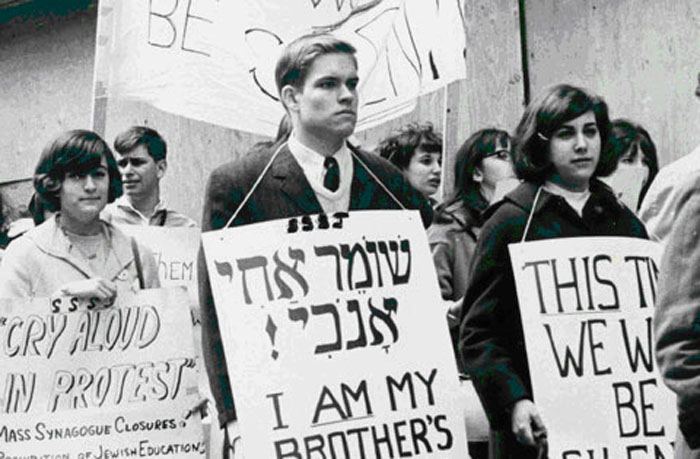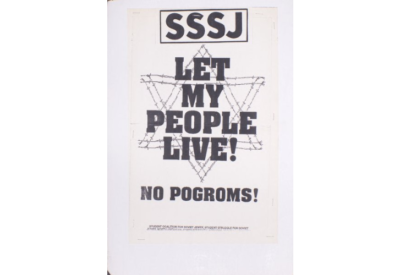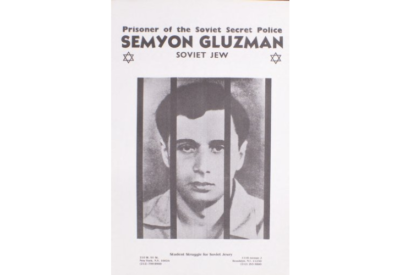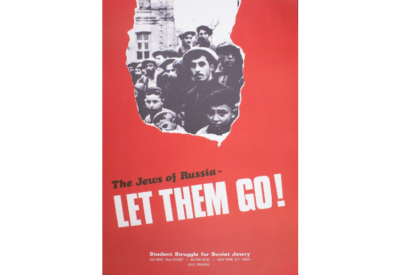My parents are too young to be historical artifacts. But they’ve seen and lived through a lot. My mother came to America in 1993 under the Jackson-Vanik amendment, a provision that put pressure on the Soviet Union to allow freedom of emigration to Jews and other groups trying to flee. My father, born in Los Angeles but bred in Montreal, remembers reading about the protests that made my mom’s immigration possible. It turns out that students – and the art they made – were a large part of that story.
My mom’s migration story is fairly unremarkable — it’s similar to that of thousands of other Soviet Jews. Born into a Jewish family in Saint Petersburg, she lived and worked in Russia until she and her family were granted refugee status to come to the US in the early 90s. Certain individuals, like Natan Sharansky, had more complicated stories: after applying for and being denied an exit visa, they had to struggle for years to leave the country.
Trying to leave meant that you were unhappy with the USSR — a fact marked on every record. It was impossible to find work for these individuals and their families, who were called “refuseniks.” Some refuseniks — though certainly not all — were heavily invested in Jewish life and Zionism, which often got them put into prison. My mom’s story is less dramatic. She never faced jail time, and soon after she arrived in the US, she met my dad at the local JCC.
But there’s more to this story than Russian refuseniks and the Jackson-Vanik amendment. In 1964, Jacob Birnbaum, a native of Germany, founded the Student Struggle to Save Soviet Jewry (SSSJ) in New York City. Although there was an “adult arm” of the organization which focused on fundraising and other “grown-up things,” the S of SSSJ was the primary, better-known part of the organization — and its “struggle” was a clear reference to the Marxist belief in class struggle.
This isn’t to say that SSSJ was the only Soviet Jewry-focused movement around. But SSSJ was special in its appeal to students. Birnbaum once wrote, in a plea to the moral conscience of young people: “Just as we, as human beings, are conscious of the wrongs suffered by the Negro and we fight for his betterment, so we must come to feel in ourselves the silent, strangulated pain of our Russian brethren.”
In 1964, he organized the first march for the liberation of his “Russian brethren.” That year, on May Day, a major Soviet holiday, one thousand Jewish young people marched for their peers across the ocean. And the movement only grew. That same year, SSSJ was launched at Columbia University, and students showed their affiliation by wearing pins that read “Concerned Jewish Student.”
The movement to free Soviet Jewry was one of the most organized and unifying movements in American Jewish history, and the fact that students helped lead the fight was not a coincidence. In fact, it was the art that they created as part of their activism that helped to catalyze change.
The posters they made and held at marches proclaimed “let my people live!” against the background of a Star of David covered in barbed wire. “No pogroms!” the poster beseeches, referring to a prewar time of Jewish persecution and drawing a parallel between the denial of human rights to Jews and the violent raids of 70 years before.
An entire series of posters, “Prisoners of the Soviet Secret Police,” featured pictures of political prisoners behind bars, including such notables as Natan Sharansky and Ida Nudel, both refuseniks who were sent to prison. Below the title of the series came the individual’s name and description — always “Soviet Jew,” as if that in itself were the crime. Jewish students recognized that their coreligionists’ crime was their Judaism, and in order to effectively communicate that to the unconcerned onlooker, they put faces the world recognized behind bars.
My personal favorite series was the “Refusenik — Trapped in Russia!” series, featuring many of the faces who went on to make Jewish history after finally gaining their freedom. Very similar to the “Prisoners of the Soviet Secret Police,” these characters were equally famous, but looked far more personable on paper. Instead of angry headshots placed behind bars, students chose more relatable photos which reminded people that the refuseniks were just humans — or rather, Jews — denied of their rights.
Some posters encouraged American Jews to send Rosh Hashanah cards to their Russian counterparts. Others posters encouraged us to “let them go!” In essence, these posters are artifacts of a student-built movement for Jewish liberation.
Some posters are Sharpie on cardboard, while others clearly took a graphic designer and a trip to Kinko’s. But what’s remarkable is the history preserved in each and every one: they give us insight into what Jewish students in the 60s, 70s, and 80s were thinking about and how they were fighting for their Soviet brethren.
Jacob Birnbaum gave students the space and opportunity to engage in the fight, and the SSSJ took to the streets with their posters. By doing so, they helped bring my mom to America.
Leora Eisenbeg is a New Voices fellow and a student at Princeton University.
Poster images courtesy of Yeshiva University, Student Struggle for Soviet Jewry Poster Collection.




